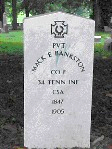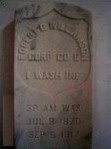
|

|
VA Burial Benefits For Confederates
Veterans Affairs and Confederate Headstones
VA Burial Benefits
VA and Confederate Benefits
Introduction
Did you know that Federal law states that all Confederate soldiers are U.S.
veterans? In other words, Confederate war veterans are considered equal to U.S. veterans of war. Did you know that the United
States honors and even pays for Confederate headstones? Did you also know that Confederate headstones are protected
by Federal law? Congressional Act of February 26, 1929 (45 Stat. 1307), authorized headstones for “soldiers who served
in the Confederate Army” buried in any place. While armies clashed
and some 620,000 Americans perished in a contest of ideals more than 150 years ago, the United States government honors
all soldiers and veterans, whether blue or gray, of the late American Civil War (1861-1865). Like it or not, an act of
Congress, U.S. law, extends Federal protection to Confederate headstones and all former Confederate soldiers are considered
U.S. veterans.
In an era of all things politically correct, the Federal government has
already taken one giant step toward burying the past, literally. While Rebel monuments, memorials, obelisks and even headstones
are currently on the receiving end of the vandal's wrath, Veterans Affairs (by Act of Congress), the current overseer of Confederate
headstones, refuses to dishonor or even take sides in a past fight that should now serve to remind us of what we were and
what we have become.
Does the Civil War, aka War of the Rebellion, War of Southern Independence,
War of Northern Aggression, War to Preserve the Union, and etc., currently serve as a timepiece of our national evolution
or a bleak lesson about racism in the country today? Do all things Confederate equate to oppression and racism? And why did
Civil War soldiers and veterans and even civilians build all the grand edifices? Did they construct the costly pieces
in order to create or recreate division and discord?
Let's take a deep breath and exhale. It
may sound odd to some, but Confederate monuments and memorials were not built for the dead, meaning those who had fought
and died during the four year struggle, but they were created for us and for future generations. The major issues of the period
were settled and put to rest on the battlefield. Both Union and Confederate soldiers and veterans of the deadliest conflict in
the history of the United States actually erected all those numerous monuments and obelisks for us, the living,
so that we might occasionally recall the sacrifices of all Americans who helped define who we are and where we come from.
To commemorate the recent sesquicentennial of the war of wills that had
ripped the nation asunder, several states unleashed a mammoth effort and formed commissions to educate the public about their
respective state's contributions. These commissions would carefully construct from interpretive to highway markers as well
as launch websites in a concerted push to inform you and I about a time in our history that pitted brother against brother
and about an era that offered all the good and bad of the country. Their collective goal is to educate
each one of us of our common history, whether it stinks or not, and that the past can continue to help us better
understand who we are today and perhaps so that we can respect the progress that we as a nation have made thus far.
It was a conflict of ideals. But it is also over. If not, do we next rip chapters from
history books and create a nationwide book burning day? Then that is not the story of us and by doing so we could never truly
appreciate the United States. The Civil War should not be refought with the
spray can or hammer or even bulldozer, for neither the vanquished nor the victor ever wished that. So perhaps we can contemplate
and consider and finally appreciate the progress that we the people have made since that fight. And by eventually
paying for all Confederate headstones, the United States government may have also demonstrated to the nation that we
are indeed all Americans.
Summary
Following the Civil War, Quartermaster Corps (QMC) assumed responsibility
for headstone procurement and issuance pursuant to Congressional Act of February 22, 1867 (14 Stat. 399), charging Secretary
of War with marking every grave in national cemeteries with a headstone. Responsibility for furnishing headstones extended
to include graves of U.S. Army combatants buried in private cemeteries, by an act of February 3, 1879 (20 Stat. 281). Further
extended to include graves of Confederate Army combatants buried in national and private cemeteries, by an act of February
26, 1929 (45 Stat. 1307). Further extended to include graves of all members of the U.S. armed forces deceased while in service
or honorably discharged from service, by an act of July 1, 1948 (62 Stat. 1215).
Federal Protection
The Cemetery Branch was established shortly after the Civil War in
the Office of the Quartermaster General. Much of the branch’s work involved establishing, maintaining, and improving
national military cemeteries as the last resting place for the war dead. On March 3, 1873, Congress granted burial rights
in national military cemeteries to all honorably discharged Union veterans of the Civil War (17 Stat. 605).
An act of Congress of February 3, 1879 (20 Stat. 281), extended the
privilege of government-provided gravestones to Union soldiers buried in private cemeteries. This act provided:
- That the Secretary of War is hereby authorized to erect headstones over the
graves of soldiers who served in the Regular or Volunteer Army of the United States during the war for the Union, and who
have been buried in private village or city cemeteries, in the same manner as provided by the law of March third, eighteen
hundred and seventy-three, for those interred in national military cemeteries. . . .
- The Secretary of War shall cause to be preserved in the records of his Department
the names and places of burial of all soldiers for whom such headstones shall have been erected by authority of this or any
former acts.
Headstones for Confederate soldiers and sailors “who died in Federal
prisons and military hospitals in the North and who were buried near their places of confinement” were authorized by
the an act of March 6, 1906 (34 Stat. 56), which required the headstones to be “similar to those recently placed over
the graves in the ‘Confederate section’” of Arlington National Cemetery. Next, the Congressional Act of
February 26, 1929 (45 Stat. 1307), authorized headstones for “soldiers who served in the Confederate Army” buried
in any place. An act of July 1, 1948 (62 Stat. 1215), extended the privilege of a government-provided headstone to all members
of the U.S. armed forces who died while in service or who had been honorably discharged. The Department of Veterans Affairs
currently oversees headstones for veterans.
Veterans Affairs

|
| VA Confederate Headstone |

|
| VA Union Headstone |
In addition to the currently available headstone and markers, Department
of Veterans Affairs (VA) offers two special styles of upright headstones for Civil War and Spanish American War
veterans - one for those who served with the Union Forces or in the Spanish-American War and another for those who served
with the Confederate Forces.
The Department of Veterans Affairs furnishes
upon request, at no charge to the applicant, a government headstone or marker for the unmarked grave of any deceased eligible
Veteran in any cemetery around the world, regardless of their date of death. If the Veteran died on or after November
1, 1990, and the grave is marked with a private headstone or marker, the Veteran may
be eligible for a medallion. Note: There is no charge for the headstone or marker itself, however arrangements for placing
it in a private cemetery are the applicant's responsibility and all setting fees are at private expense.
National Cemetery Administration (NCA) is one of three main subdivisions
of the Department of Veterans Affairs (VA) and is responsible for providing burial and memorial benefits, including headstones,
markers, and medallions, as well as maintenance of VA cemeteries.
The National Cemetery Administration maintains 131 of the 147 national
cemeteries of the United States. The Department of the Army maintains two national cemeteries: Arlington National Cemetery
and United States Soldiers' and Airmen's Home National Cemetery. The National Park Service (NPS) maintains 14 cemeteries associated
with historic sites and battlefields. United States national cemetery is a designation for 147 nationally recognized cemeteries
in the United States. A national cemetery is generally a military cemetery containing the graves of U.S. military personnel
as well as veterans and their spouses. There are also state veteran cemeteries.
The American Battle Monuments Commission, an independent agency, maintains
24 American military cemeteries and other memorials outside of the United States. The most recognized national cemetery is
Arlington National Cemetery in Arlington County, Virginia, adjacent Washington, D.C. Some national cemeteries, especially
Arlington, contain the graves of important civilian leaders and other important national figures. A few national cemeteries
also contain sections for Confederate soldiers (1861-1865). See also Introduction.
Related Reading:
Sources: Veterans Affairs; National Archives; National Park Service; Library
of Congress.
|

|

|

